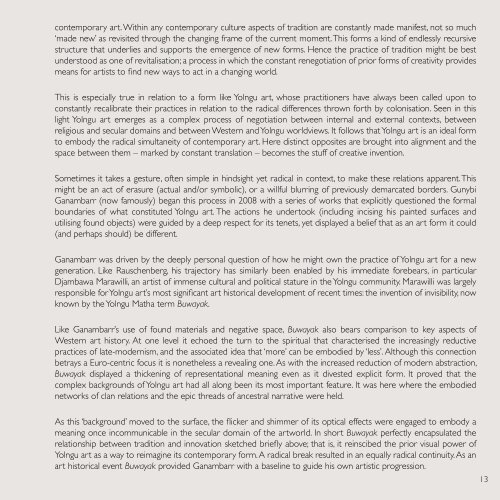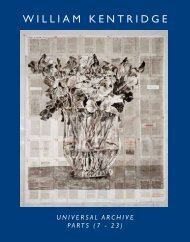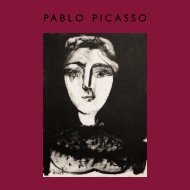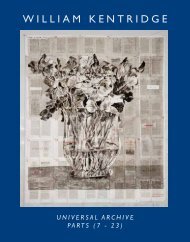Download PDF Catalogue - Annandale Galleries
Download PDF Catalogue - Annandale Galleries
Download PDF Catalogue - Annandale Galleries
Create successful ePaper yourself
Turn your PDF publications into a flip-book with our unique Google optimized e-Paper software.
contemporary art. Within any contemporary culture aspects of tradition are constantly made manifest, not so much<br />
‘made new’ as revisited through the changing frame of the current moment. This forms a kind of endlessly recursive<br />
structure that underlies and supports the emergence of new forms. Hence the practice of tradition might be best<br />
understood as one of revitalisation; a process in which the constant renegotiation of prior forms of creativity provides<br />
means for artists to find new ways to act in a changing world.<br />
This is especially true in relation to a form like Yolngu art, whose practitioners have always been called upon to<br />
constantly recalibrate their practices in relation to the radical differences thrown forth by colonisation. Seen in this<br />
light Yolngu art emerges as a complex process of negotiation between internal and external contexts, between<br />
religious and secular domains and between Western and Yolngu worldviews. It follows that Yolngu art is an ideal form<br />
to embody the radical simultaneity of contemporary art. Here distinct opposites are brought into alignment and the<br />
space between them – marked by constant translation – becomes the stuff of creative invention.<br />
Sometimes it takes a gesture, often simple in hindsight yet radical in context, to make these relations apparent. This<br />
might be an act of erasure (actual and/or symbolic), or a willful blurring of previously demarcated borders. Gunybi<br />
Ganambarr (now famously) began this process in 2008 with a series of works that explicitly questioned the formal<br />
boundaries of what constituted Yolngu art. The actions he undertook (including incising his painted surfaces and<br />
utilising found objects) were guided by a deep respect for its tenets, yet displayed a belief that as an art form it could<br />
(and perhaps should) be different.<br />
Ganambarr was driven by the deeply personal question of how he might own the practice of Yolngu art for a new<br />
generation. Like Rauschenberg, his trajectory has similarly been enabled by his immediate forebears, in particular<br />
Djambawa Marawilli, an artist of immense cultural and political stature in the Yolngu community. Marawilli was largely<br />
responsible for Yolngu art’s most significant art historical development of recent times: the invention of invisibility, now<br />
known by the Yolngu Matha term Buwayak.<br />
Like Ganambarr’s use of found materials and negative space, Buwayak also bears comparison to key aspects of<br />
Western art history. At one level it echoed the turn to the spiritual that characterised the increasingly reductive<br />
practices of late-modernism, and the associated idea that ‘more’ can be embodied by ‘less’. Although this connection<br />
betrays a Euro-centric focus it is nonetheless a revealing one. As with the increased reduction of modern abstraction,<br />
Buwayak displayed a thickening of representational meaning even as it divested explicit form. It proved that the<br />
complex backgrounds of Yolngu art had all along been its most important feature. It was here where the embodied<br />
networks of clan relations and the epic threads of ancestral narrative were held.<br />
As this ‘background’ moved to the surface, the flicker and shimmer of its optical effects were engaged to embody a<br />
meaning once incommunicable in the secular domain of the artworld. In short Buwayak perfectly encapsulated the<br />
relationship between tradition and innovation sketched briefly above; that is, it reinscibed the prior visual power of<br />
Yolngu art as a way to reimagine its contemporary form. A radical break resulted in an equally radical continuity. As an<br />
art historical event Buwayak provided Ganambarr with a baseline to guide his own artistic progression.<br />
13









